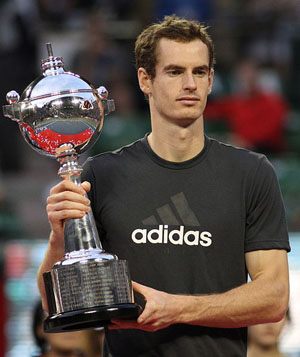 |
Born: 15 May 1987 Height: 1.90 m (6 ft 3 in) Birthplace: Glasgow, Scotland Residence: London, England Turned pro: 2004 Plays: Right-handed (two-handed backhand) Career prize money: $19,674,559 Career titles: 22 Grand Slam results Website: www.andymurray.com |
Andy Murray was born to Will and Judy in Glasgow, Scotland. Murray’s brother, Jamie, is also a professional tennis player, playing on the doubles circuit. Following the separation of his parents when he was nine years old, Andy and Jamie lived with their father. Murray is in a five-year relationship with Kim Sears, who is regularly seen attending his matches. The relationship ended briefly in 2009 before they reconciled a short time later in 2010.
Murray was born with a bipartite patella, where the kneecap remains as two separate bones instead of fusing together in early childhood. He was diagnosed at the age of 16 and had to stop playing tennis for six months. Murray is seen frequently to hold his knee due to the pain caused by the condition and has pulled out of events because of it, but manages it through a number of different approaches.
Murray began playing tennis at age 5. Leon Smith, Murray’s tennis coach from 11 to 17, said he had never seen a five-year-old like Murray, describing him as “unbelievably competitive”. At 12, Murray won his category at the Orange Bowl, a prestigious event for junior players.
At 15, Murray moved to Barcelona, Spain, where he studied at the Schiller International School and trained on the clay courts of the Sánchez-Casal Academy. Murray described this time as “a big sacrifice”. While in Spain, he trained with Emilio Sánchez, formerly the world no. 1 doubles player.
In July 2003, Murray started out on the Challenger and Futures circuit. In his first tournament, he reached the quarterfinals of the Manchester challenger. In his next tournament, Murray lost on clay in the first round to future world top-tenner Fernando Verdasco. In September, Murray won his first senior title by taking the Glasgow Futures event. He also reached the semifinals of the Edinburgh Futures event.Murray did not play seniors until May, when he retired after five games of his first-round match at the Surbiton Futures event. He returned to Futures events in Nottingham in July, where he lost to future Grand Slam finalist Jo-Wilfried Tsonga in the second round. Murray spent the whole of August playing in clay Futures events.
He won the events in Xativa and Rome, as well as reaching the semifinal of the Vigo event.In September 2004, he won the Junior US Open by beating Sergiy Stakhovsky, now a top-100 player.
(Source: http://en.wikipedia.org/wiki/Andy_Murray)
 |
 |
 |
Playing style
Murray is best described as a defensive counter-puncher; professional tennis coach Paul Annacone stated that Murray “may be the best counterpuncher on tour today.” His strengths include groundstrokes with low error rate, the ability to anticipate and react, and his transition from defence to offence with speed, which enables him to hit winners from defensive positions. His playing style has been likened to that of Miloslav Mečíř. Learn how to hit Murray´s forehand
Murray’s tactics usually involve passive exchanges from the baseline, usually waiting for an unforced error. However, Murray has been criticised for his generally passive style of play and lack of offensive weapons, prompting some to call him a pusher. He is capable of injecting sudden pace to his groundstrokes to surprise his opponents who are used to the slow rally. Murray is also one of the top returners in the game, often able to block back fast serves with his excellent reach and uncanny ability to anticipate. For this reason, Murray is rarely aced. Murray is also known for being one of the most intelligent tacticians on the court, often constructing points. Murray is most proficient on a fast surface (such as hard courts), although he has worked hard since 2008 on improving his clay court game. Early in his career, most of his main tour wins came on hard courts. However, he claimed to prefer clay courts, because of his training in Barcelona as a junior player.
Learn how to hit Murray´s forehand
(Source: http://en.wikipedia.org/wiki/Andy_Murray)
